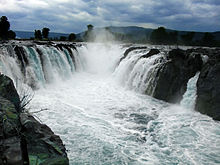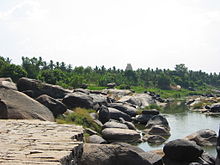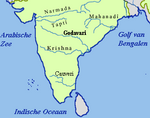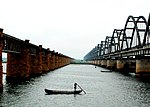Deccan Plateau
Deccan Plateau
Deccan Peninsula | |
|---|---|
Geographical region | |
 Deccan plateau (cyan) | |
| Coordinates: 15°N 77°E / 15°N 77°E | |
| Country | India |
| States | |
| Area | |
| • Total | 422,000 km2 (163,000 sq mi) |
The Deccan is a plateau extending over an area of 422,000 km2 (163,000 sq mi) and occupies the majority of the Indian peninsula. Shaped like an inverted triangle, it stretches from the Satpura and Vindhya Ranges in the north to the northern fringes of Tamil Nadu in the south. It is bound by the mountain ranges of the Western Ghats and the Eastern Ghats on the sides, which separate the region from the Western and Eastern Coastal Plains respectively. It covers most of the Indian States of Maharashtra, Telangana, Karnataka and Andhra Pradesh excluding the coastal regions, and minor portions of Tamil Nadu and Kerala.
The plateau is marked by rocky terrain with an average of about 600 m (2,000 ft). It is subdivided into Maharashtra Plateau, Karnataka Plateau, and Telangana Plateau. The Deccan Traps were formed by multiple layers of igneous rocks laid down by basaltic lava flows following a massive volcanic eruption that occurred during the end of the cretaceous period (66 mya). The underlying bed consists of sedimentary rocks formed during the precambrian era and the formation of Gondwana.
The region forms one of the major watersheds of India, with many perennial river systems such as Godavari, Krishna, and Kaveri flowing through the region. The plateau slopes gently from the west to east, resulting in most of the principal rivers flowing eastwards towards the Bay of Bengal. As the Western Ghats blocks the rain bearing winds, the plateau region is drier than the coastal region of South India and has a semi-arid climate.
The Deccan plateau region was ruled by several kingdoms in the Indian history such as Pallavas, Cholas, Pandyas, Satavahanas, Chalukyas, Rashtrakutas, Hoysalas, Kadambas, Kakatiyas, and Western Gangas. In the later medieval era, the lower plateau was ruled by the Vijayanagara empire, and the upper portion by the Bahmani kingdom, and its successors, the Deccan sultanates. It later housed the Kingdom of Mysore, Maratha confederacy, and Nizam's dominions. It was under the control of British Raj for nearly two centuries before the Indian Independence in 1947. The Reorganisation of Indian states in the 1950s resulted in the creation of states on linguistic lines.
Etymology
The word Deccan is an anglicised version of the Prakrit word dakkhaṇa, which evolved from the Sanskrit word dakṣiṇa, meaning "south".[1][2][3]
History
Carbon dating shows that ash mounds associated with Neolithic cultures in region date back to 8000 BCE. Towards the beginning of 1000 BCE, iron technology spread through the region though geological evidence does not point to a fully developed Bronze Age in existence prior to the Iron Age.[4] Since at least the 1st century BCE, the region was connected to the Silk Road and was involved in trade with the Mediterranean and East Asia.[5][6][7]
Several dynasties such as the the Pandyas of Madurai, the Cholas of Thanjavur, the Zamorins of Kozhikode, the Satavahanas of Amaravati, the Pallavas of Kanchi, the Kadambas of Banavasi, the Western Gangas of Kolar, the Rashtrakutas of Manyakheta, the Chalukyas of Badami, the Hoysalas of Belur, and the Kakatiyas of Orugallu ruled over the region from the 6th century BCE to the 14th century CE.[8] In the late middle ages, Vijayanagara empire conquered most of the southern part of the pleateu region.[8][9] The upper portion was ruled by the Bahmani kingdom,[10][11] and later by its successors, the Deccan sultanates.[12]
The Europeans arrived in the 15th century CE and by the middle of the 18th century, the French and the British were involved in a protracted struggle for military control over South India.[13] The Maratha Empire founded by Chatrapati Shivaji, briefly captured the region in the early 18th century CE.[14][15][16] After the defeat of Mysore Kingdom in the late 18th century CE and the Vellore Mutiny in 1806 CE, the British East India Company consolidated their power over much of the region. The British Empire took control of the region from the British East India Company in 1857.[17]
During the British colonial rule, the region was divided between the Madras Presidency, Bombay Presidency, Hyderabad State, and Mysore.[18][19] The region played a major role in the Indian independence movement.[20] After Indian Independence in 1947, majority of the region was organized into four states Bombay State, Hyderabad State, Madras State, and Mysore State.[21] The Reorganisation of Indian states on linguistic lines in the 1950s resulted in the creation of the states of Andhra Pradesh, Karnataka, Kerala, Maharashtra, and Tamil Nadu.[22][23][24] Telangana was created in 2014 by bifurcating Andhra Pradesh.[25][26]
Extent
Geographers have variously defined the Deccan region using indices such as rainfall, vegetation, soil type, or physical features.[27] According to one geographical definition, it is the peninsular tableland lying to the south of the Tropic of Cancer. Its outer boundary is marked by the 300 m contour line, with Vindhya-Kaimur watersheds in the north. This area can be subdivided into two major geologic-physiographic regions: an igneous rock plateau with fertile black soil, and a gneiss peneplain with infertile red soil, interrupted by several hills.[28]
Historians have defined the term Deccan differently. These definitions range from a narrow one by R. G. Bhandarkar (1920), who defines Deccan as the Marathi speaking area lying between the Godavari and Krishna rivers, to a broad one by K. M. Panikkar (1969), who defines it as the entire Indian peninsula to the south of the Vindhyas.[29] Firishta (16th century) defined Deccan as the territory inhabited by the native speakers of Kannada, Marathi, and Telugu languages. Richard M. Eaton (2005) settles on this linguistic definition for a discussion of the region's geopolitical history.[27]
Stewart N. Gordon (1998) notes that historically, the term "Deccan" and the northern border of Deccan has varied from Tapti River in the north to Godavari River in the south, depending on the southern boundary of the northern empires. Therefore, while discussing the history of the Marathas, Gordon uses Deccan as a "relational term", defining it as "the area beyond the southern border of a northern-based kingdom" of India.[30]
Geography






The Deccan plateau is a topographically variegated region located south of the Gangetic plains -the portion lying between the Arabian Sea and the Bay of Bengal- and includes a substantial area to the north of the Satpura Range, which has popularly been regarded as the divide between northern India and the Deccan. The plateau is bounded on the east and west by the Ghats, while its northern extremity is the Vindhya Range. The Deccan's average elevation is about 600 metres (2,000 ft), sloping generally eastward; its principal rivers, the Godavari, Krishna, and Kaveri, flow from the Western Ghats eastward to the Bay of Bengal. Tiruvannamalai and Vellore in Tamil Nadu is often regarded as the Southern gateway of the Deccan plateau.
The Western Ghats mountain range is very massive and blocks the moisture from the southwest monsoon from reaching the Deccan Plateau, so the region receives very little rainfall.[31][32] The eastern Deccan Plateau is at a lower elevation spanning the southeastern coast of India. Its forests are also relatively dry but serve to retain the rain to form streams that feed into rivers that flow into basins and then into the Bay of Bengal.[33][34]
Most Deccan plateau rivers flow south. Most of the northern part of the plateau is drained by the Godavari River and its tributaries, including the Indravati River, starting from the Western Ghats and flowing east towards the Bay of Bengal. Most of the central plateau is drained by the Tungabhadra River, Krishna River and its tributaries, including the Bhima River, which also run east. The southernmost part of the plateau is drained by the Kaveri River, which rises in the Western Ghats of Karnataka and bends south to break through the Nilgiri Hills at the island town of Shivanasamudra and then falls into Tamil Nadu at Hogenakal Falls before flowing into the Stanley Reservoir and the Mettur Dam that created the reservoir, and finally emptying into the Bay of Bengal.[35]
On the western edge of the plateau lie the Sahyadri, the Nilgiri, the Anaimalai and the Elamalai Hills, commonly known as Western Ghats. The average height of the Western Ghats, which run along the Arabian Sea, goes on increasing towards the south. Anaimudi Peak in Kerala, with a height of 2,695 m above sea level, is the highest peak of peninsular India. In the Nilgiris lie Ootacamund, the well-known hill station of southern India. The western coastal plain is uneven and swift rivers flow through it that form beautiful lagoons and backwaters, examples of which can be found in the state of Kerala. The east coast is wide with deltas formed by the rivers Godavari, Mahanadi and Kaveri. Flanking the Indian peninsula on the western side are the Lakshadweep Islands in the Arabian Sea and on the eastern side lie the Andaman and Nicobar islands in the Bay of Bengal.
The eastern and southeastern Deccan plateau regions which include Rayalaseema, Andhra Pradesh, majority of Bengaluru division, Part of Tamilnadu and Telangana, is made of vast sheets of massive granite rock, which effectively traps rainwater. Under the thin surface layer of soil is the impervious grey granite bedrock. It rains here only during some months.
The plateau is drained by the Godavari River taking a southeasterly course; by the Krishna River, which divides the peneplain into two regions; and by the Pennai Aaru River flowing in a northerly direction. The plateau's forests are moist deciduous, dry deciduous, and tropical thorn.
Most of the population of the region is engaged in agriculture; cereals, oilseeds, cotton, and pulses (legumes) are the major crops. There are multipurpose irrigation and hydroelectric-power projects, including the Pochampad, Bhaira Vanitippa, and Upper Pennai Aaru. Well known Industries are cotton textiles, sugar, foodstuffs, tobacco, paper, machine tools, and pharmaceuticals. Cottage industries are forest-based (timber, firewood, charcoal, bamboo products) and mineral-based (asbestos, coal, chromite, iron ore, mica, and kyanite).
Having once constituted a segment of the ancient continent of Gondwanaland, this land is the oldest and most stable in India. The Deccan plateau consists of dry tropical forests that experience only seasonal rainfall.
The large cities in the Deccan are Bengaluru, Mysuru, Tirupati, Pune, Nagpur, Nashik and Hyderabad. Other major cities include Hubli, Belagavi, Kalaburagi, Bidar, Hampi and Bellary in Karnataka; Aurangabad, Solapur, Osmanabad, Amravati, Kolhapur, Akola, Latur, Sangli, Jalgaon, Nanded, Dhule, Chandrapur, Yavatmal and Satara in Maharashtra; Hosur, Krishnagiri, Tiruvannamalai, Vellore and Ambur in Tamil Nadu; Amaravati, Visakhapatnam, Kurnool, Vijayawada, Guntur, Anantapur, Kadiri, Kadapa, Puttaparthi, Chittoor, Madanapalle, Kuppam in Andhra Pradesh; Warangal, Karimnagar, Ramagundam, Nizamabad, Suryapet, Siddipet, Nalgonda, Mahbubnagar in present-day Telangana; Jagdalpur, Kirandul, Dantewada in Chhattisgarh and Jeypore, Koraput, Bhawanipatna in Odisha in the Northeastern part of the Deccan Plateau.
Climate
The climate of the region varies from semi-arid in the north to tropical in most of the region with distinct wet and dry seasons. Some patches of desert exist in the deep centre. Rayalaseema and Vidarbha are the driest regions. Rain falls during the monsoon season from about June to October. March to June can be very dry and hot, with temperatures regularly exceeding 35 °C.
The plateau's climate is drier than that on the coasts and is arid in places. Although sometimes used to mean all of India south of the Narmada River, the word Deccan relates more specifically to that area of rich volcanic soils and lava-covered plateaus in the northern part of the peninsula between the Narmada and Krishna rivers.
Deccan Traps
The northwestern part of the Deccan Plateau, a Precambrian shield, is partially covered by the Deccan Traps ("Deccan steps"), a large igneous province made up of a series of flood basalt lava flows. This rocky material covers the whole of Maharashtra, thereby making it one of the largest Volcanic Provinces in the world. It consists of more than 2,000 metres (7,000 ft) of basalt lava flows and covers an area of nearly 500,000 km2 (190,000 sq mi) in west-central India. Estimates of the original area covered by the lava flows are as high as 1,500,000 km2 (580,000 sq mi). The volume of basalt is estimated to be 511,000 km3. The deep, dark, silty soil found here is suitable for cotton cultivation.
Geology
Typically, the Deccan Plateau is made up of basalt, an extrusive igneous rock, extending up to Bhor Ghat near Karjat. Also, in certain sections of the region we can find granite, which is an intrusive igneous rock.
The difference between these two rock types is that basalt rock forms on eruption of lava, that is, on the surface (either out of a volcano, or through massive fissures—as in the Deccan basalts—in the ground), while granite forms deep within the Earth. Granite is a felsic rock, meaning it is rich in potassium feldspar and quartz. This composition is continental in origin (meaning it is the primary composition of the continental crust). Since it cooled relatively slowly, it has large visible crystals.
Basalt, on the other hand, is mafic in composition—meaning it is rich in pyroxene and, in some cases, olivine, both of which are Mg-Fe rich minerals. Basalt is similar in composition to mantle rocks, indicating that it came from the mantle and did not mix with continental rocks. Basalt forms in areas that are spreading, whereas granite forms mostly in areas that are colliding. Since both rocks are found in the Deccan Plateau, it indicates two different environments of formation.
The volcanic basalt beds of the Deccan were laid down in the massive Deccan Traps eruption, which occurred towards the end of the Cretaceous period between 67 and 66 million years ago. Some palaeontologists speculate that this eruption may have been one of the causes of the Cretaceous-Paleogene extinction event. Layer after layer was formed by the volcanic activity that lasted many thousands of years, and when the volcanoes became extinct, they left a region of highlands with typically vast stretches of flat areas on top like a table. The volcanic hotspot that produced the Deccan traps is hypothesized to lie under the present-day island of Réunion in the Indian Ocean.[36]
The Deccan is rich in minerals. Primary mineral ores found in this region are mica and iron ore in the Chhota Nagpur region, and diamonds, gold and other metals in the Kollur region and Kolar Gold Fields.
Fauna
The large areas of remaining forest on the plateau are still home to a variety of grazing animals from the four-horned antelope (Tetracerus quadricornis),[35] chinkara (Gazella bennettii),[35] and blackbuck (Antilope cervicapra) to the gaur (Bos gaurus; /ɡaʊər/) and wild water buffalo (Bubalus arnee).
People
The northern Deccan is inhabited by Indo-Aryan peoples. Major groups include the Marathi and Deccani peoples. The Marathi language is spoken in the state of Maharashtra while the Deccani language, which is a variety of Hindustani, is spoken in northern Telangana, northeastern Karnataka and southeastern Maharashtra with the city of Hyderabad being a major stronghold of the language.
The southern Deccan is inhabited by Dravidian peoples. The prominent languages spoken by these groups are Telugu, Kannada, and Tamil, which are the majority languages of the states Telangana, Karnataka and Tamil Nadu respectively.
Economy
The Deccan plateau is very rich in minerals and precious stones.[37] The plateau's mineral wealth led many lowland rulers, including those of the Mauryan (4th–2nd century BCE) and Gupta (4th–6th century CE) dynasties, to fight over it.[38] Major minerals found here include coal, iron ore, asbestos, chromite, mica, and kyanite. Since March 2011, large deposits of uranium have been discovered in the Tummalapalle belt and in the Bhima basin at Gogi in Karnataka. The Tummalapalle belt uranium reserve promises to be one of the top 20 uranium reserve discoveries of the world.[39][40][41]
Low rainfall made farming difficult until the introduction of irrigation. Currently, the area under cultivation is quite low, ranging from 60% in Maharashtra to about 10% in Western Ghats.[42] Except in developed areas of certain river valleys, double-cropping is rare. Rice is the predominant crop in high-rainfall areas and sorghum in low-rainfall areas. Other crops of significance include cotton, tobacco, oilseeds, and sugar cane. Coffee, tea, coconuts, areca, black pepper, rubber, cashew nuts, cassava, and cardamom are widely grown on plantations in the Nilgiri Hills and on the western slopes of the Western Ghats. Cultivation of Jatropha has recently received more attention due to the Jatropha incentives in India.
See also
References
- ^ Yule, Henry; Burnell, A. C. (13 June 2013). Hobson-Jobson: The Definitive Glossary of British India. Oxford University Press. ISBN 978-0-191-64583-9.
- ^ Turner, R. L. (30 October 1966). A comparative dictionary of Indo-Aryan languages. Oxford University Press. Archived from the original on 5 November 2023. Retrieved 30 October 2023.
- ^ "Monier-Williams Sanskrit-English Dictionary". Monier-Williams. p. 498. Archived from the original on 25 May 2006. Retrieved 1 May 2006.
- ^ Agarwal, D.P (2006). Urban Origins in India (PDF). Uppsala University. p. 3. Archived from the original (PDF) on 30 May 2023. Retrieved 30 August 2023.
- ^ Schoff, Wilfred (1912). The Periplus of the Erythraean Sea: Travel And Trade In The Indian Ocean By A Merchant Of The First Century. South Asia Books. pp. 152–153. ISBN 978-8-1215-0699-1.
- ^ J. Innes, Miller (1998) [1969]. The Spice Trade of The Roman Empire: 29 B.C. to A.D. 641. Oxford University Press. p. 11,19. ISBN 978-0-1981-4264-5.
- ^ Elisseeff, Vadime (2001). The Silk Roads: Highways of Culture and Commerce. Berghahn Books. pp. 93–99. ISBN 978-9-2310-3652-1.
- ^ a b Sastri, Nilakanta (1976). A History of South India from Prehistoric Times to the Fall of Vijayanagar. Oxford University Press. pp. 7, 69, 179, 199, 214, 239. ISBN 978-0-1956-0686-7.
- ^ George C. Kohn (2006). Dictionary of Wars. Infobase Publishing. p. 597. ISBN 978-1-438-12916-7.
- ^ Jenkins, Everett (2015). The Muslim Diaspora (Volume 1, 570–1500): A Comprehensive Chronology of the Spread of Islam in Asia, Africa, Europe and the Americas, Volume 1. McFarland. p. 257. ISBN 978-1-476-60888-4.
- ^ Wink, André (2020). The Making of the Indo-Islamic World C.700–1800 CE. Cambridge University Press. p. 87. ISBN 978-1-108-41774-7.
- ^ Mitchell, George; Zebrowski, Mark (1999). Architecture and Art of the Deccan Sultanates (The New Cambridge History of India Vol. I:7). Cambridge: Cambridge University Press. p. 10. ISBN 0-521-56321-6.
- ^ Tucker, Spencer C. (2010). A global chronology of conflict. ABC-Clio. p. 756. ISBN 978-1-851-09667-1. Archived from the original on 3 June 2024. Retrieved 3 July 2020.
- ^ Pearson, M.N. (February 1976). "Shivaji and the Decline of the Mughal Empire". The Journal of Asian Studies. 35 (2): 221–235. doi:10.2307/2053980. JSTOR 2053980. S2CID 162482005.
- ^ Capper, J. (1918). Delhi, the Capital of India. Asian Educational Services. p. 28. ISBN 978-8-120-61282-2. Retrieved 6 January 2017.
- ^ Sen, S.N. (2010). An Advanced History of Modern India. Macmillan Publishers. p. 1941. ISBN 978-0-230-32885-3. Retrieved 6 January 2017.
- ^ Hibbert, Christopher (1 March 2000). Great Mutiny: India 1857. Penguin Publishing. p. 221. ISBN 978-0-140-04752-3.
- ^ "India". World Digital Library. Archived from the original on 25 August 2014. Retrieved 24 January 2013.
- ^ Imperial Gazetteer of India vol. IV. University of Chicago. 1909. p. 46.
- ^ Indian National Evolution: A Brief Survey of the Origin and Progress of the Indian National Congress and the Growth of Indian Nationalism. Cornell University Press. 22 September 2009. p. 59. ISBN 978-1-1124-5184-3.
- ^ "Article 1". Constitution of India. Ministry of Law and Justice, Government of India. Archived from the original on 2 April 2012. Retrieved 31 December 2015.
- ^ Thapar, Romesh (1978). Change and Conflict in India. Macmillan Publishers. p. 75. ISBN 978-0-8364-0222-3.
- ^ States Reorganisation Act, 1956 (PDF) (Report). High Court of Tripura. Archived (PDF) from the original on 29 September 2023. Retrieved 16 September 2023.
- ^ Reorganisation of states (PDF) (Report). Economic Weekly. 15 October 1955. Archived (PDF) from the original on 18 February 2016. Retrieved 31 December 2015.
- ^ The Andhra Pradesh Reorganisation Act, 2014 (PDF). Government of India (Report). Archived from the original (PDF) on 8 January 2016. Retrieved 3 March 2014.
- ^ "Telangana bill passed by upper house". The Times of India. 20 February 2014. Archived from the original on 20 February 2014. Retrieved 20 March 2016.
- ^ a b Eaton 2005, p. 2.
- ^ Alam 2011, p. 311.
- ^ Alam 2011, p. 312.
- ^ Gordon, Stewart (1993). The Marathas 1600–1818. The New Cambridge History of India. Cambridge University Press. p. 10. ISBN 978-0-521-26883-7. Archived from the original on 4 July 2023. Retrieved 29 October 2019.
- ^ World Wildlife Fund, ed. (2001). "South Deccan Plateau dry deciduous forests". WildWorld Ecoregion Profile. National Geographic Society. Archived from the original on 8 March 2010. Retrieved 5 January 2007.
- ^ "South Deccan Plateau dry deciduous forests". Terrestrial Ecoregions. World Wildlife Fund. Retrieved 5 January 2007.
- ^ "The Deccan Peninsula". sanctuaryasia. Archived from the original on 17 October 2006. Retrieved 5 January 2007.
- ^ "Eastern Deccan Plateau Moist Forests". World Wildlife Fund. Archived from the original on 15 April 2013. Retrieved 5 January 2007.
- ^ a b c Chisholm, Hugh, ed. (1911). . Encyclopædia Britannica. Vol. 14 (11th ed.). Cambridge University Press. pp. 375–421.
- ^ "Deccan | plateau, India". Encyclopedia Britannica. 11 April 2024. Archived from the original on 29 June 2016. Retrieved 8 August 2016.
- ^ Ottens, Berthold (1 January 2003). "Minerals of the Deccan Traps, India". HighBeam Research. Archived from the original on 11 September 2016. Retrieved 8 August 2016.
- ^ Deccan Plateau, India. Encyclopædia Britannica. Archived from the original on 29 June 2016. Retrieved 8 August 2016.
- ^ Subramanian, T. S. (20 March 2011). "Massive uranium deposits found in Andhra Pradesh". news. Chennai, India: The Hindu. Archived from the original on 24 October 2012. Retrieved 8 August 2016.
- ^ Thakur, Monami (19 July 2011). "Massive uranium deposits found in Andhra Pradesh". International Business Times. USA. Archived from the original on 18 October 2017. Retrieved 8 August 2016.
- ^ Bedi, Rahul (19 July 2011). "Largest uranium reserves found in India". The Telegraph. New Delhi, India. Archived from the original on 12 January 2022.
- ^ "Peninsular India". ita. September 1995. Archived from the original on 28 October 2016. Retrieved 8 August 2016.
Bibliography
- Alam, Shah Manzoor (2011). "The Historic Deccan - A Geographical Appraisal". In Kalpana Markandey; Geeta Reddy Anant (eds.). Urban Growth Theories and Settlement Systems of India. Concept. ISBN 978-81-8069-739-5.
- Eaton, Richard M. (2005). A Social History of the Deccan, 1300–1761. Cambridge University Press. ISBN 978-0-5212-5484-7.
External links
 Media related to Deccan Plateau at Wikimedia Commons
Media related to Deccan Plateau at Wikimedia Commons- Dynasties of Deccan




